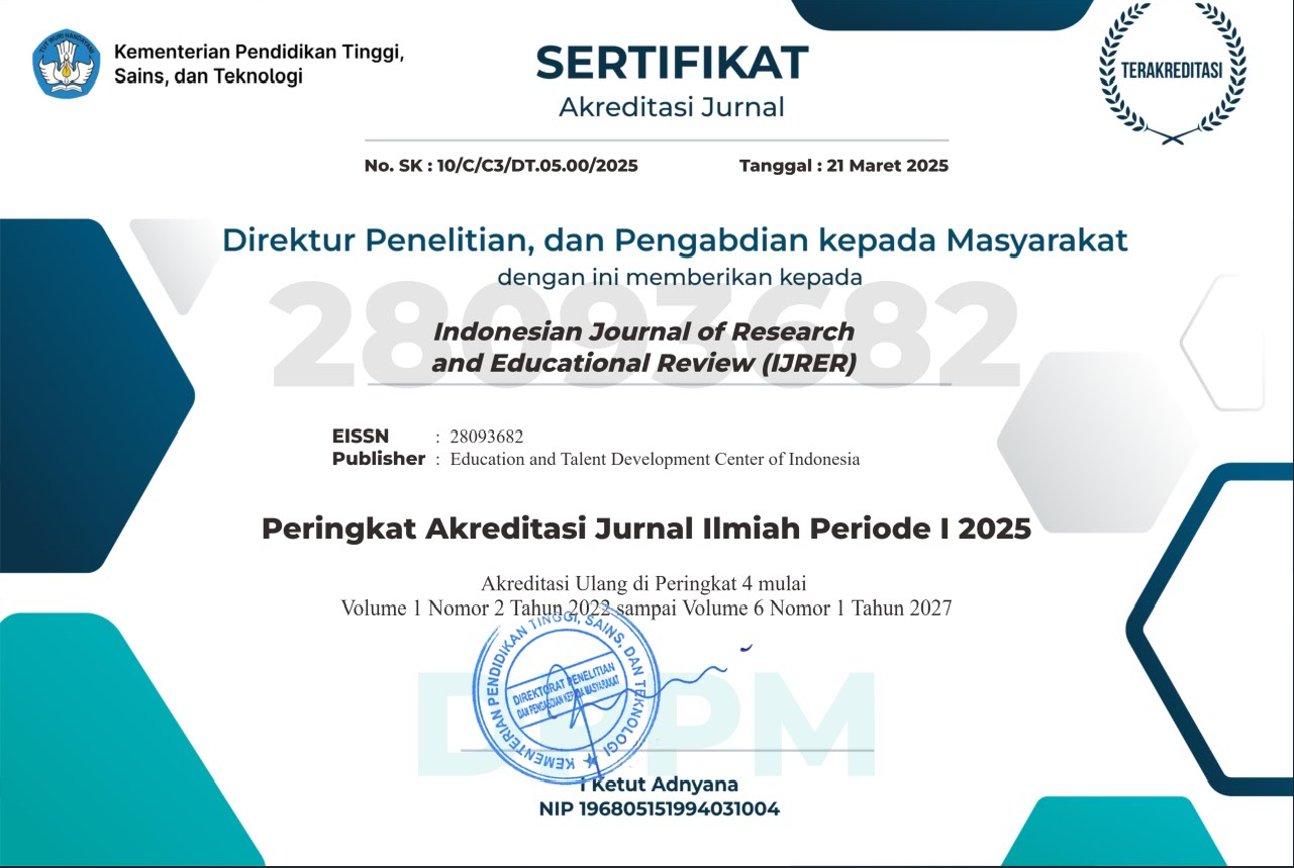The Impact of Using A Reciprocal Teaching Strategy on Reading Comprehension By Prospective Teachers
DOI:
https://doi.org/10.51574/ijrer.v1i2.334Keywords:
Reciprocal Teaching, Strategy, Reading ComprehensionAbstract
The goal of this study was to improve students' reading comprehension using a Reciprocal Teaching Strategy in the fourth semester of IAI As'adiyah Sengkang's English education. The researcher used a pre-experimental design that included a pretest and a posttest. The sample comprised of 20 students drawn from IAI As'adiyah Sengkang's fourth semester English education students utilizing a cluster random selection approach. This study used a 20-item multiple-choice reading test as the research tool. Pre-test and post-test data were obtained. The data analysis revealed that the mean score of the students' pre-tests was 59, 29 and the mean score of the post-test was 77,62. It was discovered that pupils' reading comprehension improved after undergoing Reciprocal Teaching treatment (0.05). The researcher concluded that Reciprocal Teaching Strategy was appropriate in teaching reading comprehension at IAI As'adiyah Sengkang's fourth semester of English education. The reciprocal Teaching technique can be used as an alternative strategy in the teaching and learning process by English teachers and other scholars.
References
Alfassi, M., Weiss, I., & Lifshitz, H. (2009). The efficacy of reciprocal teaching in fostering the reading literacy of students with intellectual disabilities. European Journal of Special Needs Education, 24(3), 291-305. https://doi.org/10.1080/08856250903016854
Arif, A. (2016). Increasing The Students’reading Comprehension By Using Reciprocal Teaching Strategy. Jurnal Pendidikan Bahasa, 3(1), 1-14. http://dx.doi.org/10.31571/bahasa.v3i1.171
Barrett, R. A. (2003). Reciprocal teaching as a Platform for communicative activities in the secondary foreign language classroom: A case study. The University of Akron.
Chang, M. M., & Lan, S. W. (2021). Exploring undergraduate EFL students’ perceptions and experiences of a Moodle-based reciprocal teaching application. Open Learning: The Journal of Open, Distance and e-Learning, 36(1), 29-44. https://doi.org/10.1080/02680513.2019.1708298
Ciampa, K., & Gallagher, T. L. (2018). A comparative examination of Canadian and American pre-service teachers’ self-efficacy beliefs for literacy instruction. Reading and Writing, 31(2), 457-481. https://doi.org/10.1007/s11145-017-9793-6
Creswell, J. W., & Creswell, J. D. (2017). Research design: Qualitative, quantitative, and mixed methods approaches. Sage publications.
Doolittle, P. E., Hicks, D., Triplett, C. F., Nichols, W. D., & Young, C. A. (2006). Reciprocal teaching for reading comprehension in higher education: A strategy for fostering the deeper understanding of texts. International Journal of Teaching and Learning in Higher Education, 17(2), 106-118.
Goodwin, A. P., Huggins, A. C., Carlo, M. S., August, D., & Calderon, M. (2013). Minding morphology: How morphological awareness relates to reading for English language learners. Reading and Writing, 26(9), 1387-1415. https://doi.org/10.1007/s11145-012-9412-5
Guthrie, J. T., Wigfield, A., Barbosa, P., Perencevich, K. C., Taboada, A., Davis, M. H., ... & Tonks, S. (2004). Increasing reading comprehension and engagement through concept-oriented reading instruction. Journal of educational psychology, 96(3), 403. https://doi.org/10.1037/0022-0663.96.3.403
Hasan, A., Gushendra, R., & Yonantha, F. (2018). The influence of prior knowledge on students’ listening and reading comprehension. IJEE (Indonesian Journal of English Education), 4(1), 1-15. https://doi.org/10.15408/ijee.v4i1.4744
Hashemi, A. (2021). The effects of using games on teaching vocabulary in reading comprehension: a case of gifted students. Journal for the Education of Gifted Young Scientists, 9(2), 181-191. https://doi.org/10.17478/jegys.846480
Islam, S. (2020). Implementing reciprocal teaching method in improve the students’reading comprehension ability. ETERNAL (English, Teaching, Learning, and Research Journal), 6(1), 96-110. https://doi.org/10.24252/Eternal.V61.2020.A9
Jegerski, J. (2013). Self-paced reading. In Research methods in second language psycholinguistics (pp. 36-65). Routledge. https://www.taylorfrancis.com/chapters/edit/10.4324/9780203123430-8/self-paced-reading-jill-jegerski
Li, P., & Clariana, R. B. (2019). Reading comprehension in L1 and L2: An integrative approach. Journal of Neurolinguistics, 50, 94-105. https://doi.org/10.1016/j.jneuroling.2018.03.005
Lipka, O., & Siegel, L. S. (2012). The development of reading comprehension skills in children learning English as a second language. Reading and Writing, 25(8), 1873-1898. https://doi.org/10.1007/s11145-011-9309-8
List, A., Brante, E. W., & Klee, H. L. (2020). A framework of pre-service teachers’ conceptions about digital literacy: Comparing the United States and Sweden. Computers & Education, 148, 103788. https://doi.org/10.1016/j.compedu.2019.103788
Mannong, A. B. M. (2018). The implementation of reciprocal teaching method (RTM) in developing reading comprehension of the second grade students of SMAN 2 Bantaeng. INTERACTION: Jurnal Pendidikan Bahasa, 5(2), 1-12. https://doi.org/10.36232/jurnalpendidikanbahasa.v5i2.177
Maspufah, M. (2019). Improving Students’ Reading Comprehension by Using Reciprocal Teaching Strategy. J-SHMIC: Journal of English for Academic, 6(1), 26-32. https://doi.org/10.25299/jshmic.2019.vol6(1).2639
Megawati, F. (2016). Kesulitan mahasiswa dalam mencapai pembelajaran bahasa Inggris secara efektif. PEDAGOGIA: Jurnal pendidikan, 5(2), 147-156. https://doi.org/10.21070/pedagogia.v5i2.246
Nation, K., & Norbury, C. F. (2005). Why reading comprehension fails: Insights from developmental disorders. Topics in language disorders, 25(1), 21-32.
Oo, T. Z., Magyar, A., & Habók, A. (2021). Effectiveness of the reflection-based reciprocal teaching approach for reading comprehension achievement in upper secondary school in Myanmar. Asia Pacific Education Review, 22(4), 675-698. https://doi.org/10.1007/s12564-021-09707-8
Okkinga, M., van Steensel, R., van Gelderen, A. J., & Sleegers, P. J. (2018). Effects of reciprocal teaching on reading comprehension of low‐achieving adolescents. The importance of specific teacher skills. Journal of research in reading, 41(1), 20-41. https://doi.org/10.1111/1467-9817.12082
Paul, A. K., & Karmaker, P. R. (2021). Examining the Role of Reciprocal Teaching in Enhancing Reading Skill at First-Year Undergraduate Level in a Semi-Urban College, Bangladesh. i-Manager's Journal on English Language Teaching, 11(1), 1.
Pilonieta, P., & Medina, A. L. (2009). Reciprocal teaching for the primary grades:“We can do it, too!”. The reading teacher, 63(2), 120-129. https://doi.org/10.1598/RT.63.2.3
Rastle, K. (2019). The place of morphology in learning to read in English. Cortex, 116, 45-54. https://doi.org/10.1016/j.cortex.2018.02.008
Reis, A., Araújo, S., Morais, I. S., & Faísca, L. (2020). Reading and reading-related skills in adults with dyslexia from different orthographic systems: a review and meta-analysis. Annals of dyslexia, 70(3), 339-368. https://doi.org/10.1007/s11881-020-00205-x
Shanahan, T., & Shanahan, C. (2008). Teaching disciplinary literacy to adolescents: Rethinking content-area literacy. Harvard educational review, 78(1), 40-59. https://doi.org/10.17763/haer.78.1.v62444321p602101
Soto, C., Gutiérrez de Blume, A. P., Jacovina, M., McNamara, D., Benson, N., & Riffo, B. (2019). Reading comprehension and metacognition: The importance of inferential skills. Cogent Education, 6(1), 1565067. https://doi.org/10.1080/2331186X.2019.1565067
Spörer, N., Brunstein, J. C., & Kieschke, U. L. F. (2009). Improving students' reading comprehension skills: Effects of strategy instruction and reciprocal teaching. Learning and instruction, 19(3), 272-286. https://doi.org/10.1016/j.learninstruc.2008.05.003
Takala, M. (2006). The effects of reciprocal teaching on reading comprehension in mainstream and special (SLI) education. Scandinavian Journal of Educational Research, 50(5), 559-576. https://doi.org/10.1080/00313830600953824
Tarchi, C. (2015). Fostering reading comprehension of expository texts through the activation of readers’ prior knowledge and inference-making skills. International Journal of Educational Research, 72, 80-88. https://doi.org/10.1016/j.ijer.2015.04.013
Tseng, S. S., & Yeh, H. C. (2018). Integrating reciprocal teaching in an online environment with an annotation feature to enhance low-achieving students’ English reading comprehension. Interactive Learning Environments, 26(6), 789-802. https://doi.org/10.1080/10494820.2017.1412989
Westhisi, S. M. (2019). Metode fonik dalam pembelajaran membaca permulaan bahasa inggris anak usia dini. Tunas Siliwangi: Jurnal Program Studi Pendidikan Guru PAUD STKIP Siliwangi Bandung, 5(1), 23-37. https://doi.org/10.22460/ts.v5i1p29-43.1271
Yawisah, U. (2017). Reciprocal Teaching: One of the methods for poor comprehenders. Pedagogy: Journal of English Language Teaching, 1(1), 21-25. https://e-journal.metrouniv.ac.id/index.php/pedagogy/article/view/354









1.png)













